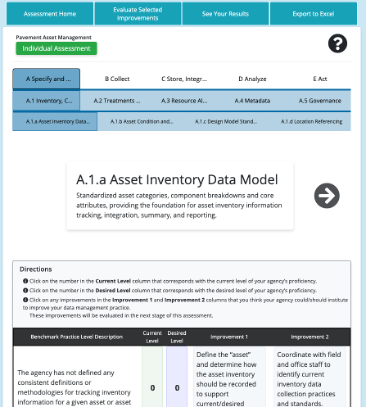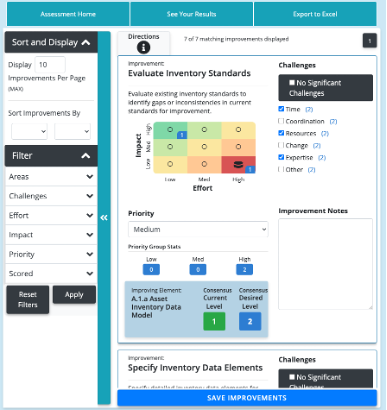Calculating asset value requires data on the asset inventory, on asset age or condition, and on asset treatments. The availability of asset data, or lack of it, may impact what approach an agency uses for calculating asset value. Also, it may impact what assets are included in the calculation and the level of detail at which calculations are performed.
Collecting and maintaining quality asset data can be a significant investment in and of itself. If needed data are unavailable, an agency may be able to expend additional resources to collect additional data and/or improve data quality. Thus, questions about data availability can become questions about resources: are the resources available to collect the desired data? This section discusses what data are needed for calculating asset value and approaches for assessing asset data.
Table 3-2 summarizes data needs for calculating asset value. This information may be available from a range of agency management systems and data repositories. As indicated in the table, certain types of data are required regardless of the approach one uses. Other data may be needed depending on the specific approach. This point at this step is to determine what data are actually available to help support decisions about the scope of the calculation. Key considerations include:
- Inventory data are critical for the calculation, but the level of detail required in the asset inventory depends upon the specific application. Having a comprehensive inventory of all assets is ideal, but often neither achievable nor necessary for the purpose of calculating asset value. Often it is feasible to use summary data on an asset inventory to calculate asset value – e.g., the distribution of assets by age or condition for a given asset class or subclass. Also, assets are frequently included implicitly as part of another asset rather than being inventoried explicitly.
- Some form of data is needed regarding the current condition of the asset inventory using either asset age, condition, or a mix of the two. This is used to depreciate asset value. Chapter 6 discusses issues regarding calculation of depreciation. Often the availability of this data is a limiting factor in calculating value.
- The availability of treatment data is critical for establishing what treatments are considered in the calculation. This topic is discussed further in Chapter 5. For any treatment that is included it is imperative to have a unit cost. If historic costs are used as the basis for the calculation, then ideally one would have historic costs as well, but historic costs can be approximated given unit treatment costs and information on asset age.
- Various other parameters may be required for the asset value calculation, particularly if calculating market or economic value. These approaches are discussed further in Chapter 4.
Table 3-2. Data Needs for Asset Value Calculation
| Inventory Data | |
| Always Needed Asset quantity by:
| May Be Needed
|
Challenges
|
|
| Condition Data | |
Always Needed
| May Be Needed
|
| Treatment Data | |
Always Needed
| May Be Needed Historic data on treatments performed by:
|
Challenges
|
|
| Other Data and Parameters | |
Always Needed
| May Be Neeeded
|
Challenges
|
|
In assessing what data are available, one should also consider the quality and completeness of the data, noting any significant concerns. Common issues in this regard include, but are not limited to:
- Data may be available for a given subset of the inventory (e.g., for a given asset class and/or district), but may not be available consistently across the agency. For many asset classes data on a statistical sample of the assets are acceptable.
- Inventory and/or condition data may be available for a given point in time, but may not be consistently maintained.
- There may be limited data on what treatments have been performed on a given asset since it was first constructed. This can be an issue if one is relying on asset age rather than condition to establish depreciation, particularly if one also seeks to include other treatments besides asset construction/reconstruction in the approach.
- There may be other changes over time that changes in data over time that may difficult to track and that further complicate use of historic data. This may include changes in the network (e.g., which highways are included in the NHS), changes in asset ownership, and/or changes in data collection approaches.
- Information on current and predicted future asset use needed for calculating economic value may be unavailable or difficult to obtain.
The process of assessing the data available for calculating asset value may be performed as part of a broader assessment of an agency’s asset data resources and needs. NCHRP Report 956: Guidebook for Data and Information Systems for Transportation Asset Management presents an approach for assessing an organization’s current data and information management practices in support of TAM, as well as strategies for improving these practices (17). An agency can apply the guidebook comprehensively to all of the organization’s TAM activities or use it to focus on particular components, such as components related to calculating asset value.
Figure 3-1 reproduces the “Data Life-Cycle Framework” from NCHRP Report 956. This shows the different elements of an organization’s asset data included as part of an assessment. The framework organizes the assessment items into five categories. Of these, two are most relevant for assessment of data for asset valuation: A. Specify and Standardize; and B. Collect.

NCHRP Report 956 is accompanied by a web tool, the TAM Data Assistant, to support the assessment of TAM data needs. Together the guidebook and the tool offer an organized process for evaluating and improving an agency’s data systems. This web tool is hosted by AASHTO and available for public agency use.
The screenshots below show the primary two steps in the tool’s process. First, users assess their data system using benchmarks provided for each of the five areas outlined in Figure 3-1. Then, in the screen on the right, they evaluate their selected improvements to prepare an implementation plan.


In addition to guidance for the TAM Data Assistant, the report provides case studies demonstrating the importance and impact of data improvements across state DOTs and resources for those facilitating the assessment. For more information about the tool and the NCHRP Report, visit www.tamdataguide.com.
Source: NCHRP Report 956 (17)